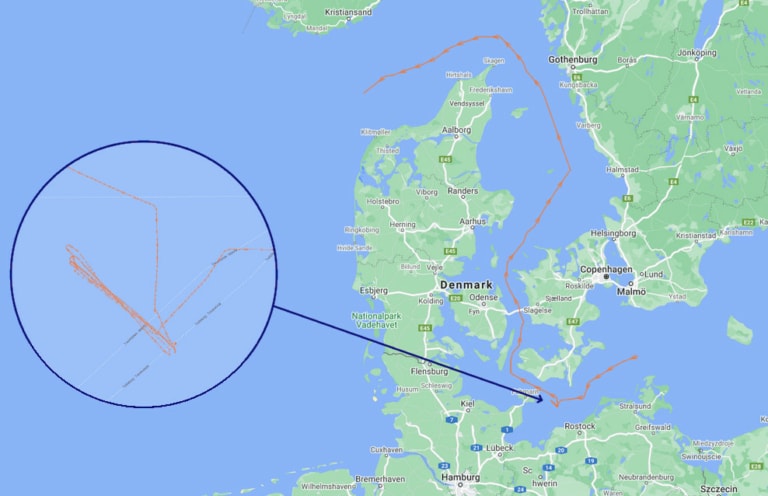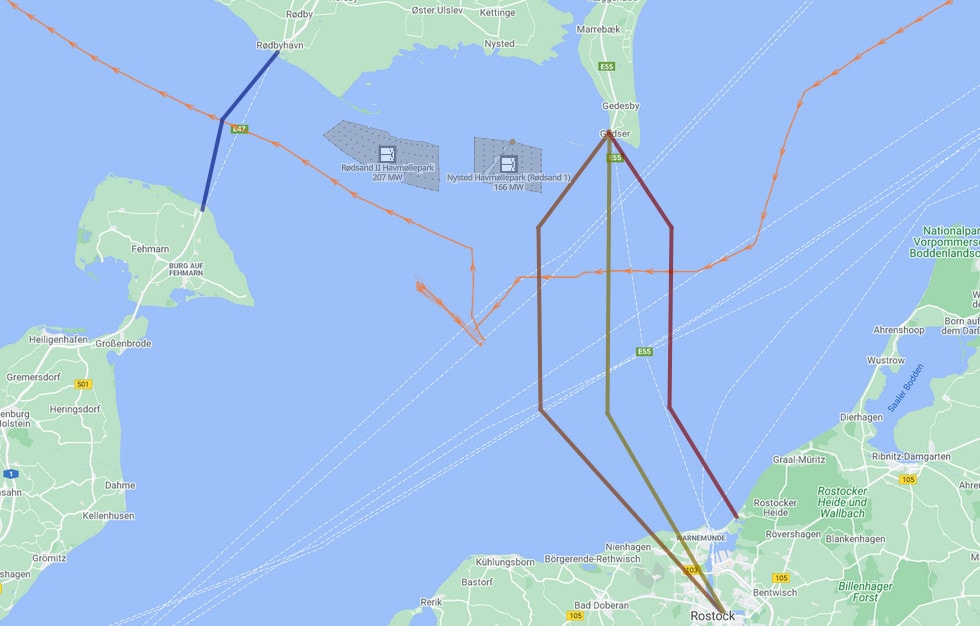
Officially, the Russian ship Evgeny Gorigledzhan is a research vessel.
In reality, it is a state-of-the-art military intelligence ship belonging to one of Russia’s most secretive and offensive military underwater units. A ship with heavy capabilities to map, survey and, in extreme cases, sabotage critical seabed infrastructure.
For this very reason, it has caused a stir that the spy ship on its maiden voyage appears to have sailed directly from its shipyard in Kaliningrad to the Danish-German waters of the Fehmarn Belt.
Publicly available AIS data – i.e. position signals transmitted from the ship itself – reveals that Evgeny Gorigledzhan has made a number of unusual manoeuvres over a small piece of seabed near the future Fehmarn Belt fixed link. Seemingly unnoticed for many hours before a small German coastguard vessel shows up to keep an eye out.

What exactly Evgeny Gorigledzhan did near Fehmarn is still unknown. But the voyage certainly seems suspicious, says Jens Wenzel Kristoffersen, lieutenant commander and military analyst at the Centre for Military Studies at the University of Copenhagen.
“I can only say that the ship has not just been in transit. Nor is it normal for a ship of this category to sail back and forth on more or less the same opposite course for a long period of time, unless it is a diversionary manoeuvre and to attract the attention of the authorities.”
“One may wonder why their AIS transmitter is on while they’re down there rummaging around. But perhaps it is a matter of seeing how we react to something like that. Just as the Russians do in the air, where their fighters jets enter Danish airspace to test our preparedness,” he says.
The spy ship stopped not far from where the Fehmarn fixed link is being built. There are also several undersea data and power cables nearby. According to publicly available records, the area includes four internet cables between Denmark and Germany and two offshore wind farms near the Danish coast.
However, according to AIS records, the vessel was not directly over any of these cables as it sailed back and forth over the same small area for over 24 hours.

Having left the Fehmarn Belt in the early hours of 16 October, Evgeny Gorigledzhan passed the Great Belt Bridge later in the morning. Here, a number of amateur marine photographers captured the vessel as it passed.
Danwatch and Ekstra Bladet have also come into possession of a number of photographs by another photographer, who wishes to remain anonymous.
The photos were also taken near the Great Belt Bridge, and you can clearly see that there are armed soldiers in full uniform among the ship’s crew.
It is not unusual for Russian military vessels to sail through Danish waters with armed guards. In the documentary series ‘The Shadow War’, Danmarks Radio documented that this was also the case on the research vessel Admiral Vladimirsky.
Yet the photos emphasise that the Evgeny Gorigledzhan is no ordinary civilian vessel.
According to AIS data analysed and shared by user @auonsson on X, the “Neustadt”, a German coastguard vessel, can be seen sailing quietly towards Evgeny Gorigledzhan in the waters around Fehmarn.
But the Germans arrive only after the Russian research vessel has been carrying out its mysterious manoeuvres for eight hours.
The fact that the Danes apparently are nowhere to be seen for such a long time – at least according to the publicly available position data – is very puzzling to military analyst Jens Wenzel Kristoffersen.
“It seems very, very strange that we don’t seem to be paying more attention to what’s going on,” he says.
“Based on the AIS data, it seems to take up to eight hours for a small German coastguard vessel to arrive. Eight hours in the middle of the night, with this vessel going back and forth, doing something. And you have to remember that this isn’t just anyone. GUGI is well-known. These are highly professional people,” he says.
“Anyone who sits in a command centre and follows ship traffic should be wondering about this. It’s not a civilian ferry, it’s a special unit! It should have immediately set off the loudest alarm bells.”
Only 18 hours after the Russian spy ship began its manoeuvres off Fehmarn, and some time after the ship had passed through the Great Belt, a small Danish patrol ship left Frederikshavn and followed the Russians for three hours before the patrol returned home. For all three hours, Evgeny Gorigledzhan had switched off its AIS transmitter – the only period of time during the more than 62 hours the vessel was in Danish waters.
As soon as Evgeny Gorigledzhan exited the Skagerrak and entered the North Sea, the AIS transmitter was switched off again. The last ping sent by the ship indicated that it was heading south along the west coast of Denmark.
Subsequently, the Dutch media Pointer has made it probable that the Dutch navy may have sent a patrol vessel after an unknown vessel with its AIS transmitter switched off near the Netherlands. Apparently, the blacked-out vessel was in the vicinity of the East Anglia 1 wind farm and the Interconnector gas pipeline that connects the UK to the European mainland.
A spokesperson for the Dutch Ministry of Defense confirms to Danwatch and Ekstra Bladet that they have spotted Evgeny Gorigledzhan near the Netherlands:
“We have been aware of this Russian vessel in the North Sea and the waters between the Netherlands and the UK. We have been monitoring the case closely, but due to operational considerations we will not give more details for now.”
The UK is also said to have sent a Boeing P-8 patrol aircraft to the same area, where it flew in a zigzag pattern over a small area. Several larger British warships have since been spotted in the same area. A Royal Navy spokesman declines to comment on specific operations, but tells Danwatch:
“We routinely monitor activity in UK waters and its Exclusive Economic Zone (EEZ) and maintain a presence to counter and deter potential threats.”
Danwatch has asked the Defense Command in Denmark why the Russian spy ship was apparently able to make its unusual voyage unattended for such a long time, but the Defense Command says it cannot provide an answer this week.
We have also contacted the Danish Defense Vessel Traffic Service (VTS) at the Fehmarn Belt, the German coastguard at Schleswig-Holstein, the German navy and the Russian embassy in Denmark, but none of them has responded to our inquiries by the deadline.